The AMPnoPRO and AMP scores help physicians understand how ready a person is for a prosthetic limb and how well they are adapting to it after fitting. These scores break movement into small, clear steps. Each step shows how strong the person is, how steady they feel, and how confident they are using their body. For amputees, these scores give a simple picture of their journey from early recovery to long-term independence.
For physicians, the scores act like a roadmap. Before the user gets a prosthetic limb, the AMPnoPRO score shows what the body can do without one. After fitting, the AMP score shows how much the prosthetic helps, where the user struggles, and what kind of support they need next. The scores guide decisions about training, component choices, and safety.
This article explains how these scores work and how clinicians can use them in a practical, human way. It explores what the numbers mean, how to interpret them, and how to use them to shape better rehab plans before and after prosthetic fitting.
Understanding the AMPnoPRO and AMP Tools
What the AMPnoPRO Measures
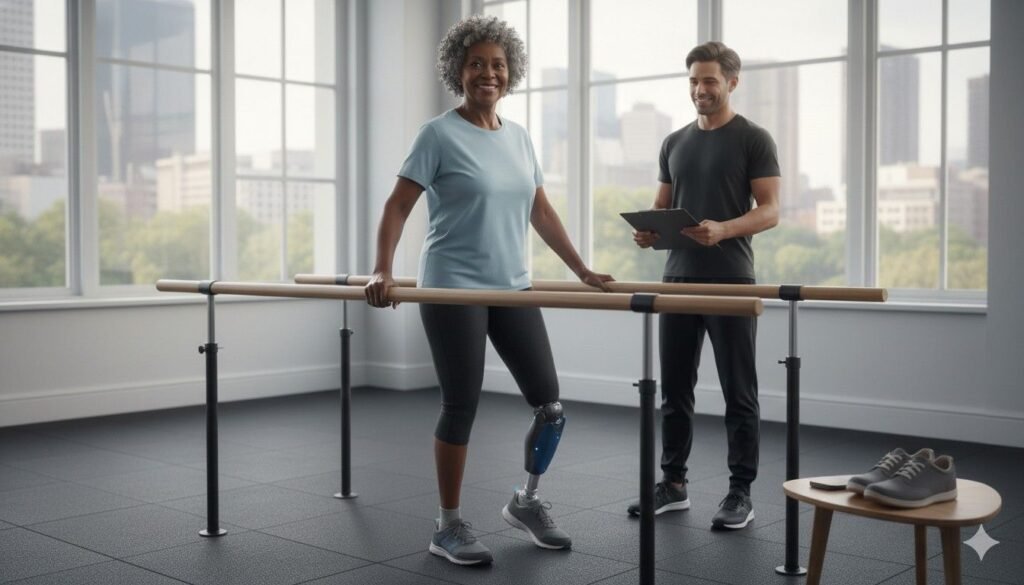
The AMPnoPRO score measures how well a person moves without a prosthetic limb.
It looks at simple tasks like standing, reaching, hopping, and balancing.
These small actions show how ready the user is for a prosthesis and what kind of support they will need.
The score helps physicians understand the person’s natural strength.
If someone struggles without a prosthesis, they may need extra training before fitting.
This prevents injuries and gives the user a safer starting point.
The AMPnoPRO also shows the person’s confidence level.
Even before fitting, fear or hesitation can slow movement.
These emotional signs guide early therapy and education.
What the AMP Measures After Fitting
The AMP score measures movement once the user begins using a prosthetic limb.
It looks at how well they stand, walk, balance, and move with the device on.
This score helps physicians see how much support the prosthesis provides.
If the user moves well with the limb, it shows a good fit and strong potential.
If their score remains low, something in the setup may need attention.
The AMP also reveals how confidently the user relies on their prosthesis.
If they trust the device, their movements become smoother and faster.
If they doubt it, they may hesitate or compensate, slowing progress.
Why These Scores Matter in Real Life
These scores help physicians make better decisions for the user’s safety.
They show how ready the user is for walking, stairs, uneven surfaces, or community activity.
Doctors also use these scores to guide therapy.
They show which muscles need work, which movements feel unsafe, and which daily tasks need more practice.
The scores also help the user understand their own progress.
Seeing improvement builds hope and motivation.
This emotional boost helps users stay engaged in rehab.
How Physicians Use AMPnoPRO Before Prosthetic Fitting
Understanding the User’s Starting Point
Before fitting, every user begins at a different level.
Some people are strong and confident from the start.
Others feel uncertain or weak because surgery, pain, or fear have slowed their recovery.
The AMPnoPRO score helps doctors see where the person stands today.
It shows which movements they can manage and which feel hard.
This creates a clear, honest baseline.
Without this baseline, rehab can feel confusing or overwhelming.
The score makes early planning easier and safer.
Planning Pre-Prosthetic Training
Pre-prosthetic training helps strengthen the body so the user can handle a prosthetic limb.
The AMPnoPRO score highlights exactly which areas need improvement.
If the user struggles with standing, training focuses on hip and core strength.
If balancing feels unsafe, exercises help build stability.
If hopping or pivoting scares them, gentle practice helps reduce fear.
These steps prepare the body for the challenge ahead.
A well-prepared body adapts faster once the prosthesis is fitted.
Deciding the Right Time for Fitting
Fitting a prosthetic limb too early can cause pain, skin issues, or long-term problems.
Fitting too late can slow emotional recovery and reduce motivation.
The AMPnoPRO score helps physicians choose the right moment.
If the user scores high enough, their body is ready for the next step.
If the score remains low, they may benefit from more training first.
This timing protects the user from injury and builds confidence.
Helping the User Set Realistic Expectations
Many amputees worry about what life will look like with a prosthetic limb.
Some expect quick progress, while others fear they will never walk again.
The AMPnoPRO score gives doctors a clear way to explain what to expect.
It shows the user their strengths and their challenges.
It gives them a realistic picture of their potential.
When expectations are clear, the journey feels easier and less stressful.
How Physicians Use AMP Scores After Fitting
Measuring Early Adaptation
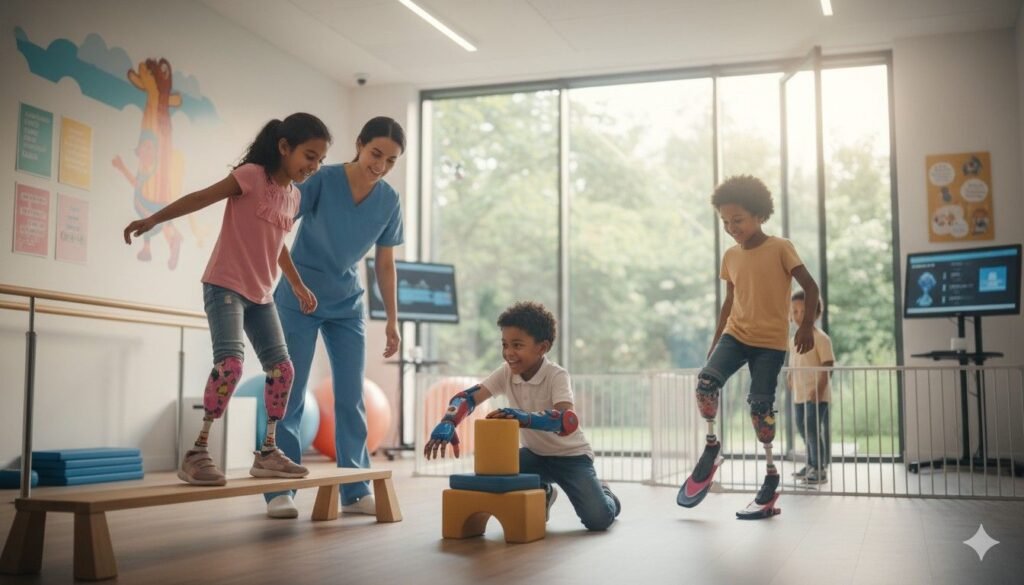
Once the prosthesis is fitted, the AMP score becomes a guide for early progress.
It shows how quickly the user adapts to the limb and how well they manage basic tasks.
A rising score in the early weeks shows growing trust and strength.
A flat or dropping score shows that the user needs extra support.
This early insight helps physicians protect the user from falls or frustration.
Understanding Prosthetic Alignment Needs
Alignment affects every part of movement.
If the foot is tilted too far forward or the knee feels unstable, the user may hesitate.
The AMP score quickly shows alignment problems.
If the user struggles with stepping, turning, or balancing, alignment may be the cause.
Fixing alignment often leads to immediate improvement.
This makes the score a practical tool for prosthetists as well.
Guiding Therapy Sessions
Therapists use AMP scores to design sessions that match the user’s needs.
If the user has trouble with weight shifting, therapy focuses on safe loading.
If the user struggles with balance, training targets trunk control and stable stepping.
The score shows exactly what needs work.
This targeted approach makes rehab faster and more meaningful.
Supporting Safety Planning
Falls are one of the biggest fears for new amputees.
A low AMP score often shows high fall risk.
Doctors use the score to decide when the user can go home, walk independently, or try more complex environments.
This protects the user during vulnerable moments.
Safety planning becomes clear and confident with AMP scores.
Specific Movements Within the AMPnoPRO and AMP Tests
Standing Up and Sitting Down
Standing and sitting are basic, everyday movements.
But for amputees, these tasks can feel overwhelming in early recovery.
The AMP tests show how safely the user performs these actions.
If they push too hard with their arms or lean too much to one side, it signals weakness or fear.
Improving these movements builds independence quickly.
They help shape the user’s comfort at home and in public places.
Balancing in Place
Balance reveals how steady and confident the user feels.
Poor balance often leads to falls or hesitation during walking.
The AMP tests show whether the user can balance without holding onto something.
They also show how long they can stay steady before shifting or wobbling.
Balance training becomes a major part of rehab when these scores are low.
Stepping Forward and Backward
Stepping shows how well the user controls the prosthetic limb.
A smooth step means the limb fits well and the user feels safe.
A hesitant step means fear, weakness, or discomfort.
Backward stepping is especially revealing because it requires strong trust.
These movements help doctors understand the user’s real comfort level.
Walking With or Without Aid
Some users need a cane or walker at first.
Others may be able to walk without support.
The AMP score shows when the user is ready to reduce assistance.
It gives doctors a safe way to guide each step toward independence.
Removing support too early can cause injury.
The score prevents such risks.
AMPnoPRO and AMP as Predictors of Future Movement
Predicting Gait Quality
Gait becomes smoother as strength and confidence grow.
AMP scores reveal whether the user is moving toward stable gait patterns.
A user with a rising score often shows cleaner steps and less compensation.
A low or flat score may show alignment problems or emotional hesitation.
These scores help doctors predict how well the user will walk in the future.
Predicting Activity Level
Higher AMP scores often show that the user will be active in daily life.
Lower scores may show they will move less and avoid physical tasks.
Understanding activity levels helps physicians protect long-term health.
Inactivity can lead to muscle loss, weight gain, and emotional decline.
AMP scores support early interventions that keep users moving.
Predicting Component Needs
AMP scores also guide prosthetic component choices.
If the user scores high, they may need a more active foot or a microprocessor knee.
If they score low, a simpler setup may be safer at first.
This keeps the prosthesis matched to the user’s real needs and goals.
Predicting Return to Work
Workplaces require safe movement, fast reactions, and good balance.
AMP scores help doctors decide when the user is ready to return.
A strong score shows confidence and readiness.
A weak score shows the need for more training.
AMP helps shape a realistic, supportive return-to-work plan.
Using AMPnoPRO to Shape Early Rehabilitation Plans
Understanding Strength Needs
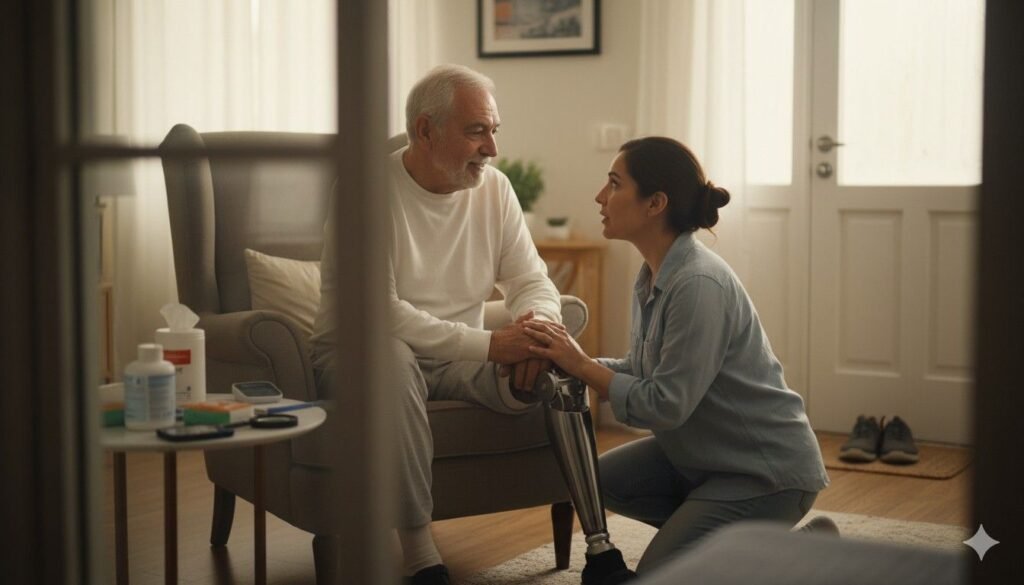
The AMPnoPRO score gives a very clear picture of the user’s physical strength before they ever touch a prosthetic limb.
It shows how well their hips, core, and remaining leg can support daily movement.
When a person struggles with standing, lifting, or shifting weight, the score makes it easy to see which muscles need immediate attention.
This early insight allows doctors and therapists to design training that prepares the body for the physical demands of wearing a prosthesis.
Instead of guessing, they know exactly where weakness exists.
By strengthening these areas early, the user’s transition into the prosthesis becomes smoother and far less stressful.
For example, if the user cannot maintain balance for a few seconds, the therapist knows they must first build core stability before introducing standing exercises with a prosthetic limb.
Small wins in these early stages create a strong foundation for everything that comes later.
Understanding Pain and Discomfort Patterns
Pain often limits how freely a user moves, even before prosthetic fitting.
If someone takes tiny steps or avoids bearing weight, the AMPnoPRO score helps physicians understand where the discomfort is hidden.
Pain may come from the residual limb, the surgical site, or the muscles that have been underused for months.
By watching how the user performs each AMPnoPRO task, doctors can identify patterns that reveal deeper issues.
For example, a person who avoids leaning forward may be afraid of pressure on the limb; someone who rushes movements may be hiding balance insecurity.
These clues help guide early pain management strategies, stretching routines, and gentle mobility exercises.
When pain is addressed early, the user becomes far more confident when the prosthesis is finally fitted.
Revealing Emotional Readiness
The AMPnoPRO test is also a window into the user’s emotional world.
Many amputees carry fear, sadness, or doubt after surgery.
Even a simple movement, like standing from a chair, can trigger anxiety.
When users hesitate during tasks, hold their breath, or look down constantly, it shows emotional strain.
These moments are just as important as the physical results.
Doctors use these signs to slow the pace, provide reassurance, or bring in counseling support when needed.
Emotional readiness shapes every part of recovery.
A person who feels supported is more willing to try new movements, trust therapists, and stay engaged in rehab.
The AMPnoPRO score helps physicians recognize when encouragement, not just exercise, is required.
Planning Safe Weight-Bearing
The AMPnoPRO score helps determine how safely a user can put weight through their limbs before wearing a prosthetic.
If they are unable to maintain balance or shift weight smoothly, the physician knows that early prosthetic walking will be risky.
Understanding weight-bearing safety also helps prevent falls during early rehabilitation.
If the user leans heavily on furniture or pushes through their arms during tasks, it shows that they do not yet trust their lower body.
Training can then focus on controlled, slow-loading exercises to build confidence and stability.
This careful planning allows the body to adjust before the additional challenge of prosthetic alignment enters the picture.
How AMP Scores Guide Post-Prosthetic Rehabilitation
Identifying Early Wins and Barriers
Once the prosthetic limb is fitted, the AMP score becomes a valuable tool to measure early wins.
It reveals which movements the user can now perform more easily and which ones still feel frightening or painful.
A user may be able to stand more confidently with the prosthesis, but struggle with stepping backward or turning.
These insights help therapists reinforce strengths while targeting weak points.
When users see improvement in their AMP scores, even small ones, their confidence grows naturally.
Barriers become clearer as well.
If the user performs worse with the prosthesis than without it, something is wrong — maybe the socket hurts, the knee feels stiff, or the suspension is too loose.
The AMP test helps reveal these issues without guesswork.
Fine-Tuning Prosthetic Components
Prosthetic components do not work perfectly on the first day.
They need careful adjustment, tuning, and sometimes replacement.
The AMP score shows how well each part supports movement.
If the user struggles with sitting down, the foot may be absorbing too little shock.
If they hesitate during stepping, the knee might be too slow or too quick in its response.
If they wobble during balance tasks, the alignment may be shifting pressure unevenly.
These clues help prosthetists fine-tune the device with precision.
Small adjustments often lead to dramatic improvements in the user’s AMP score.
This feedback loop makes the fitting process far more reliable and user-centered.
Strengthening Trust in the Prosthetic Limb
Many amputees hesitate to trust their prosthetic limb.
They may fear the knee will buckle, the foot will slip, or the socket will pinch.
This fear influences their AMP score more deeply than physical weakness.
As the user practices AMP tasks — such as stepping, reaching, or turning — they slowly realize what the prosthesis can do for them.
Their posture becomes more upright, their steps become more relaxed, and their movements become more natural.
The AMP score tracks this growth in trust.
A rising score shows not just improvement in movement, but a shift in mindset.
Trust is the heart of long-term success with a prosthetic limb.
Guiding Transition to Independent Walking
AMP results help physicians decide when the user is ready to walk independently without constant supervision.
A strong performance across balance and stepping tasks shows they can manage daily activities like moving around their home or walking in public spaces.
The score also helps determine when the user can safely reduce assistive devices.
If they score well with a cane, they may be ready to try walking without one.
If they struggle, keeping the cane prevents dangerous falls.
Gradual progression ensures the user gains confidence without unnecessary risk.
Understanding How AMPnoPRO and AMP Compare
How AMPnoPRO Predicts AMP
The AMPnoPRO score acts like a preview of how the user will perform once fitted with a prosthesis.
If they show strong balance, good strength, and steady movement without a prosthesis, their AMP score later tends to be higher.
On the other hand, users with low AMPnoPRO scores may require extensive rehabilitation before their AMP score begins to rise.
This connection helps doctors set realistic goals and timeframes for recovery.
It also helps the user understand the journey ahead.
When expectations are grounded in data, the process feels less frightening and more hopeful.
How Scores Reveal the Impact of the Prosthesis
Comparing AMPnoPRO and AMP scores shows exactly how much the prosthesis improves the user’s movement.
If the AMP score is far higher than the AMPnoPRO score, the device is supporting the user very well.
If both scores remain low, deeper issues need attention.
Pain, poor alignment, socket discomfort, or emotional fear may be slowing progress.
The comparison gives physicians a clear view of the prosthesis’s true value.
It also helps identify whether the device needs adjustments or upgrades.
How Scores Shape Long-Term Mobility Planning
The AMPnoPRO score shows where the user begins, and the AMP score shows where they are headed.
Together, they guide long-term planning for mobility, independence, and quality of life.
If the user shows steady improvement, physicians may introduce advanced tasks like stair climbing, uneven surfaces, or faster walking.
If progress is slow, the plan may focus more on strength, balance, and emotional reassurance.
These scores help build a long-term roadmap that feels realistic and supportive.
Using AMPnoPRO and AMP for Fall Prevention
Identifying Physical Weakness That Leads to Falls
Falls often occur when the user feels weak in key areas such as the hips, core, or residual limb.
The AMPnoPRO score reveals these weaknesses early, long before prosthetic fitting takes place.
If the user cannot balance on one leg, shift weight smoothly, or maintain upright posture, they are more likely to fall once they begin walking with a prosthesis.
By spotting these weaknesses early, physicians can build a safer training plan.
After fitting, the AMP score shows whether the prosthesis increases or decreases fall risk.
Slow transitions, wobbling, or hesitation during turning movements show high risk.
These signals help doctors intervene quickly before falls occur.
Catching Emotional Patterns That Cause Falls
Fear and stress can cause falls just as easily as weak muscles.
A user who fears falling may freeze during movement or take small, unstable steps.
Both AMPnoPRO and AMP scores capture these emotional signs.
If the user scores low in tasks requiring balance or turning, fear may be the root cause.
Once clinicians see these emotional patterns, they can help through reassurance, gentle exposure, and confidence-building exercises.
Emotional safety is just as important as physical safety.
Planning Safer Home Environments
AMP scores often reveal how safely the user will move at home.
If they struggle with reaching or balance, they may need support bars, non-slip flooring, or better lighting.
Physicians use the scores to guide families on how to make the home safer.
This prevents accidents and allows the user to move more freely.
When home feels safe, confidence naturally grows.
Using AMP Scores for Prosthetic Prescription and Insurance Documentation
Helping Physicians Choose the Right Components
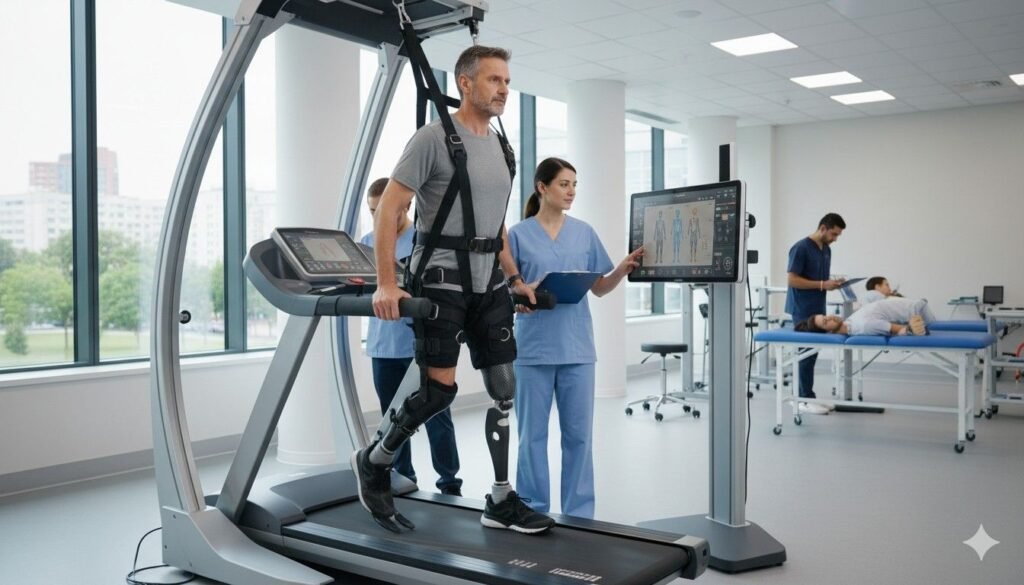
AMP scores help physicians justify the need for advanced prosthetic components.
If the user shows strong potential, a high-activity foot or a microprocessor knee may be appropriate.
If the user requires more basic support, a simpler design may meet their needs.
These decisions become easier when clinicians have clear, measurable evidence from AMP scores.
The score supports the user’s case for the best device possible.
Supporting Insurance Approvals
Many insurance providers require clear documentation showing why a certain prosthetic component is necessary.
AMP scores provide objective evidence.
A higher score may support the need for advanced technology.
A lower score may support the need for therapy or targeted training before upgrading.
When documentation is strong, users receive the components they need without delays.
Communicating With the Full Care Team
AMP results help all members of the care team stay aligned.
Physical therapists, prosthetists, physicians, and family members can all understand the user’s progress through the scores.
This shared understanding improves communication, reduces errors, and builds a unified support system.
The scores become the common language of care.
Long-Term Tracking With AMPnoPRO and AMP
Understanding Recovery Over Months and Years
AMPnoPRO and AMP scores help physicians see how recovery unfolds over long periods.
Early progress is often quick, but long-term progress requires patience and consistency.
By checking scores regularly, doctors can see whether the user is gaining strength, staying stable, or starting to slow down.
These long-term patterns reveal how the body adapts as life changes.
Some users stay active and improve steadily, while others may decline due to age, pain, or reduced physical activity.
Tracking these scores over time helps clinicians adjust goals and support the user through each season of their journey.
Long-term scoring creates a clear, honest picture that guides care with confidence.
Spotting Early Declines Before They Become Problems
A small drop in AMP score may look minor, but it can signal deeper issues.
It may show that the user is moving less at home or avoiding certain tasks because of swelling, discomfort, or fear.
These early clues help physicians intervene before the user loses independence.
Declines may also show when a prosthetic foot or knee is wearing down.
As components age, they offer less support and require more energy to use.
AMP scores help detect these changes long before the user realizes something is wrong.
Early action protects comfort, confidence, and safety.
Tracking Emotional Changes Through Movement
Movement often reveals emotional changes more clearly than words.
A user who was confident before may suddenly appear hesitant in certain tasks.
Their AMP score may drop slightly or remain flat even when strength is improving.
These quiet signs often point to emotional stress, fear of falling, or frustration with daily challenges.
When physicians see these patterns, they can support the user with reassurance, counseling, or simpler goals.
Tracking emotional progress through movement helps build a more compassionate rehab plan.
Supporting Aging Users
As users age, their strength and balance naturally shift.
AMP scores help physicians understand how aging interacts with prosthetic use.
A slow increase in time or reduction in task performance may show that the user needs new training or component upgrades.
These scores help keep aging users active, safe, and confident.
They also provide a clear path for adjusting goals as life circumstances evolve.
The scores become a lifelong guide, not just a short-term tool.
AMPnoPRO and AMP in Collaborative Care
Helping Prosthetists Understand User Needs
Prosthetists rely on AMP scores to see how well the device supports movement.
The score highlights alignment problems, balance issues, and weight-bearing challenges.
This helps prosthetists adjust foot stiffness, knee settings, and socket design with precision.
A higher score after adjustments confirms that the prosthesis is helping as intended.
A flat score shows that more work is needed.
Clear scores create smoother teamwork between the medical and prosthetic teams.
Helping Therapists Personalize Treatment
Physical therapists use AMPnoPRO and AMP scores to tailor each session.
They can see which movements feel safe and which feel risky.
They can also track how quickly the user is mastering new skills.
Therapists use this information to pace the program correctly.
If the user moves quickly through tasks, sessions can become more challenging.
If progress slows, exercises can be simplified until confidence returns.
AMP-guided therapy is more efficient and more encouraging.
Supporting Families With Clear Updates
Families often feel unsure about how to support their loved one after amputation.
AMP scores give them a simple way to understand progress without needing medical knowledge.
When families see the numbers, they feel more confident about how to help.
They can celebrate progress, encourage good habits, and prepare the home environment safely.
This shared understanding reduces stress and strengthens the support network around the user.
Communicating With Insurance and Funding Agencies
AMP scores provide measurable evidence of functional ability.
Insurance providers often require these measures for approving components, therapy sessions, or upgrades.
Clear scores make documentation easier and reduce delays.
They help the care team advocate for the user and ensure they receive the equipment needed for safe mobility.
Objective results build a stronger case than words alone.
Supporting Return-to-Work and Lifestyle Goals
Using Scores to Plan Return-to-Work Timelines
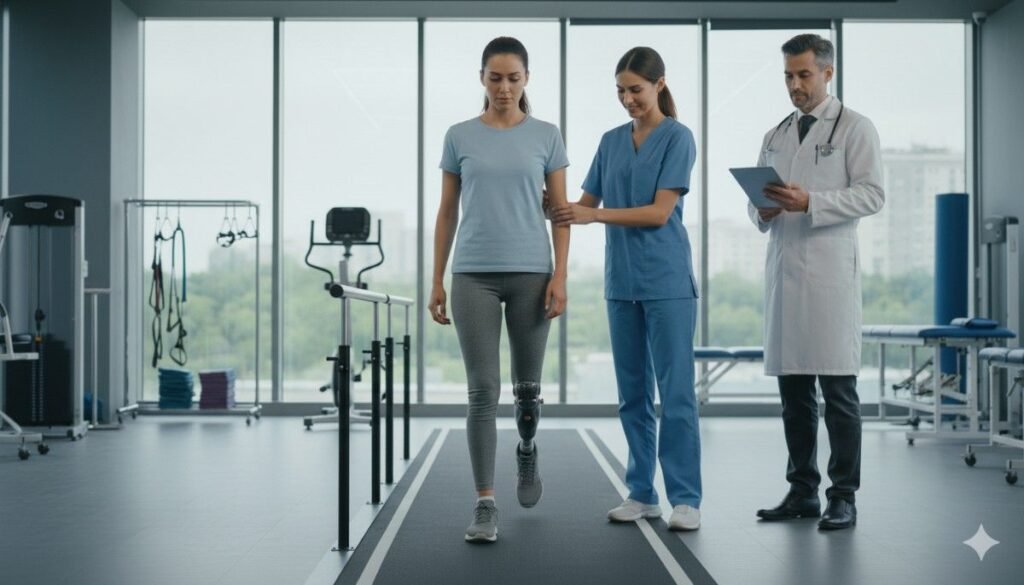
Returning to work requires balance, endurance, and safe movement.
AMP scores help physicians understand whether the user is ready for these demands.
A high score may show that the user can manage longer days, frequent walking, and tasks requiring quick turning.
A lower score may show the need for more training before returning.
These measured insights help create a realistic plan that protects the user from overexertion or injury.
Supporting Active Lifestyles
Many amputees want to return to hobbies, exercise, or sports.
AMP scores help physicians understand whether the user is ready for higher-level movement.
If the user shows strong balance and confidence, they can safely explore physical activities like cycling, hiking, or dancing.
If the score shows weakness or fear, the plan can introduce gentle conditioning first.
Using scores to guide activity reduces risk and builds confidence.
Helping Users Set Personal Goals
Goal-setting becomes easier when AMPnoPRO and AMP results reveal clear strengths and challenges.
Users may set goals like walking outdoors, climbing stairs, visiting friends, or traveling.
The scores help shape these goals into small, manageable steps.
Each improvement becomes a emotional victory that encourages further progress.
Goals become more meaningful and easier to achieve when they are rooted in clear, measurable progress.
Measuring Readiness for Advanced Components
Higher-level components like energy-return feet or microprocessor knees require a certain level of control.
AMP scores show whether the user is ready to benefit from these technologies.
If the score is rising steadily, advanced components may help unlock greater comfort and freedom.
If the score is low, basic components may be safer until the user builds more stability.
These decisions ensure each person receives the right technology at the right time.
The Role of AMP Scores in Lifelong Prosthetic Health
Planning Annual Check-Ups
AMP scores help physicians plan annual prosthetic reviews.
Over time, limb volume, alignment, and comfort change naturally.
The score reveals when it is time for a new socket or updated components.
When the score drops without a clear cause, physicians know to look deeper.
This proactive approach prevents long-term discomfort or injury.
Annual scoring makes prosthetic care consistent and predictable.
Monitoring Activity Decline
Many users become less active due to lifestyle changes, aging, or emotional stress.
A decline in AMP score helps clinicians notice this shift early.
Once identified, doctors can introduce new exercises, adjust prosthetic settings, or recommend lifestyle changes that restore activity.
This protects the user’s health, independence, and emotional well-being.
Understanding When Users Need More Support
Life events like illness, weight change, or surgery can affect prosthetic function.
AMP scores clearly show when extra support is needed.
A sudden drop in score may signal that the user needs therapy, a new socket, or emotional counseling.
Tracking this helps prevent bigger setbacks.
AMP scores ensure the right help arrives at the right time.
Encouraging Lifelong Confidence
The most powerful gift AMP scores offer is confidence.
When users see steady progress, they trust their bodies and their prosthetic limbs more deeply.
Even during tough seasons, the score reminds them how far they have come.
This sense of growth fuels long-term independence and pride.
Progress becomes a personal story they can hold onto.
Conclusion
The AMPnoPRO and AMP scores give physicians and users a clear, simple way to understand progress before and after prosthetic fitting.
They show how the body moves, how stable each step feels, and how confident the user becomes over time.
These scores guide decisions about therapy, component choices, safety planning, and long-term mobility in a way that feels practical, supportive, and deeply human.
By watching how a user stands, steps, turns, and balances, the scores reveal the real story behind their recovery.
They help clinicians shape care that feels personal, realistic, and hopeful.
They also help users see their own growth, celebrate their wins, and believe in their future again.
At Robobionics, we believe mobility should feel natural, safe, and full of dignity.
Our prosthetic limbs are designed to support this journey with care, precision, and affordability.
If you’d like to explore how our solutions can help your patients experience smoother progress and stronger AMP outcomes, you can always book a demo through our website.
We are honored to walk this journey with you — one step, one score, and one success at a time.



